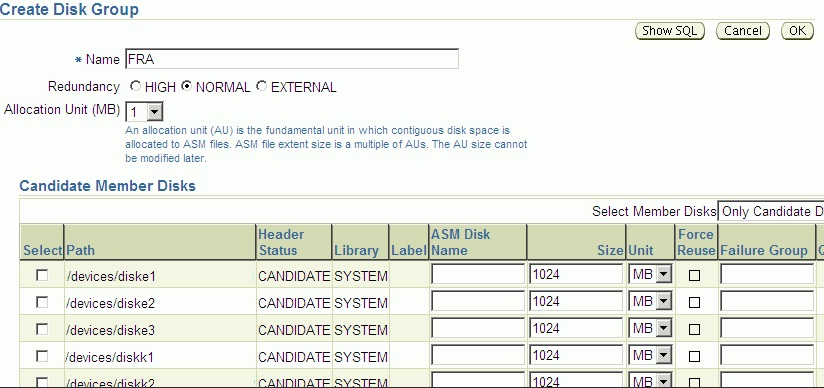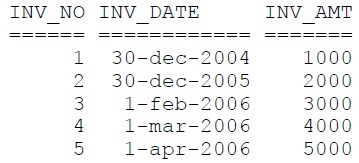You are managing an Oracle Database 11g instance with ASM storage. You lost an ASM
- A. Restore the disk group with the exact configuration as the backed-up disk group, using the same disk group name, same set of disks, failure group configurations, and data on the disk group.
- B. Restore the disk group with the exact configuration as the backed-up disk group, using the same disk group name, same set of disks, and failure group configurations.
- C. Restore the disk group with changed disk group specification, failure group specification, disk group name, and other disk attributes.
- D. Restore metadata in an existing disk group by passing the existing disk group name as an input parameter.
Answer : B,C,D
Explanation:
Purpose -
The md_restore command restores disk groups from a metadata backup file.
Syntax and Description -
md_restore backup_file [--silent]
[--full|--nodg|--newdg -o 'old_diskgroup:new_diskgroup [,...]']
[-S sql_script_file] [-G 'diskgroup [,diskgroup...]']
backup_file
Reads the metadata information from backup_file.
--silent
Ignore errors. Typically, if md_restore encounters an error, it stops. Specifying this flag ignores any errors.
--full
Specifies to create a disk group and restore metadata.
--nodg
Specifies to restore metadata only.
--newdg -o old_diskgroup:new_diskgroup]
Specifies to create a disk group with a different name when restoring metadata. The -o option is required with
--newdg.
-S sql_script_file
Write SQL commands to the specified SQL script file instead of executing the commands.
-G diskgroup
Select the disk groups to be restored. If no disk groups are defined, then all disk groups are restored.
View the Exhibit and examine the disk groups created at the time of migrating the database storage to Automatic Storage Management (ASM).

Why does the FRA disk group initially have more free space even though both DATA and
FRA disk groups are provided with the same size?
- A. Because the FRA disk group will not support dynamic rebalancing
- B. Because the FRA disk group is not configured to support mirroring
- C. Because disks in the FRA disk group are not formatted at this stage
- D. Because the FRA disk group will support only a single size of allocation unit
Answer : B
You are managing an Oracle Database 11g instance and an Oracle Database 10g instance on the same machine. Both instances use the ASM instance as storage. Which statement regarding the ASM disk group compatibility attributes are true in this scenario? (Choose all that apply.)
- A. The database-compatibility version settings for each instance must be greater than or equal to the RDBMS compatibility of all ASM disk groups used by that database instances.
- B. RDBMS compatibility and the database version determines whether a database instance can mount the ASM disk group.
- C. The RDBMS compatibility settings for a disk group control the format of data structures for ASM metadata on the disk.
- D. ASM compatibility controls which features for the ASM will be enabled.
Answer : A,B,D
The INV_HISTORY table is created using the command:

The following data has been inserted into the INV_HISTORY table:

You would like to store the data belonging to the year 2006 in a single partition and issue the command:
SQL> ALTER TABLE inv_history -
MERGE PARTITIONS -
FOR(TO_DATE('15-feb-2006','dd-mon-yyyy')),
FOR(TO_DATE('15-apr-2006'))
INTO PARTITION sys_py;
What would be the outcome of this command?
- A. It executes successfully, and the transition point is set to '1-apr-2006'.
- B. It executes successfully, and the transition point is set to '15-apr-2006'.
- C. It produces an error because the partitions specified for merging are not adjacent.
- D. It produces an error because the date values specified in the merge do not match the date values stored in the table.
Answer : C
In your database, the LDAP_DIRECTORY_SYSAUTH initialization parameter has been set to YES and the users who need to access the database as DBAs have been granted
SYSDBA enterprise role in Oracle Internet Directory (OID). SSL and the password file have been configured. A user SCOTT with the SYSDBA privilege tries to connect to the database instance from a remote machine using the command:
$ SQLPLUS scott/tiger@DB01 AS SYSDBA
Which DB01 is the net service name.
Which authentication method would be used first?
A. authentication by password file
B. authentication by using certificates over SSL
C. authentication by using the Oracle Internet Directory
D. authentication by using the local OS of the database server
Answer : A Topic 2, Configuring for Recoverability
Which of the following does the recover command not do?
- A. Restore archived redo logs.
- B. Apply archived redo logs.
- C. Restore incremental backups.
- D. Apply incremental backups.
- E. Restore datafile images.
Answer : A
What is the purpose of the list expired backup command?
- A. Lists all backups impacted by a resetlogs command
- B. Lists all backups that are subject to retention criteria
- C. Lists all backups that are missing associated physical backup set pieces
- D. Lists the status of datafile backup failures due to the use of the duration command
- E. Lists backups that cannot be used by the restore command because they have been marked as disabled
Answer : C
Your database has a backup that was taken yesterday (Tuesday) between 13:00 and 15:00 hours. This is the only backup you have. You have lost all the archived redo logs generated since the previous Monday, but you have archived redo logs available from the previous
Sunday and earlier. You now need to restore your backup due to database loss.
To which point can you restore your database?
- A. 13:00 on Tuesday.
- B. 15:00 on Tuesday.
- C. Up until the last available archived redo log on Sunday.
- D. To any point; all the redo should still be available in the online redo logs.
- E. The database is not recoverable.
Answer : E
Which of the following parameters defines the location where Oracle should create archived redo logs?
- A. LOG_ARCHIVE_1
- B. LOG_DESTINATION_1
- C. LOG_ARCHIVED_DESTINATION_1
- D. LOG_ARCHIVE_DEST_1
- E. LOG_ARCHIVE_SOURCE_1
Answer : D
The application tables owned by the user TEST in a test database need to be exported to the APPS schema in the production database by using Data Pump. Which option of Data
Pump Import would you use to accomplish this?
- A. owner
- B. touser
- C. attach
- D. remap_schema
Answer : D
As soon as you discover that you have lost an online redo log, if the database is still functioning, what should be your first action?
- A. Shut down the database
- B. Clear the online redo log
- C. Back up the database
- D. Checkpoint the database
- E. Call Oracle support
Answer : D
Which RMAN backup command is used to create the block-change tracking file?
- A. alter database create block change tracking file
- B. alter database enable block change file
- C. alter database enable block change tracking using file '/ora01/opt/block_change_tracking.fil'
- D. alter system enable block change tracking using file '/ora01/opt/block_ change_tracking.fil'
- E. alter system block change tracking on
Answer : C
Your archive-log destination directory runs out of space. What is the impact of this on the database?
- A. None. The database will switch over to the stand-by archive-log destination directory.
- B. A warning message will be written to the alert log of the database, but no adverse impacts to the database will be experienced.
- C. The database will shut down, and will not restart until you correct the out-of-space situation.
- D. The database will continue to try to write to the archive-log destination directory for one hour. After one hour, the database will shut down normally.
- E. Once Oracle has cycled through all online redo logs, it will stop processing any DML or DDL until the out-ofspace condition is corrected.
Answer : E
Every Sunday the Unix system administrator has a job that executes a full backup of the entire Unix system your database is on. Is this backup usable for backup and recovery of your database?
- A. Yes, if the database is in ARCHIVELOG mode.
- B. Yes, if the database is in NOARCHIVELOG mode.
- C. No, the backup is not usable in any way.
- D. Only if the ENABLE_ONLINE_BACKUP parameter is set to TRUE.
Answer : C
You want to use the automatic management of backup and recovery operations features for your database.
Which configuration must you set?
- A. Enable the flash recovery area and specify it as the archived redo log destination.
- B. Disable the flash recovery area and start the database instance in ARCHIVELOG mode.
- C. Enable the flash recovery area but do not specify it as the archived redo log destination.
- D. Disable the flash recovery area and start the database instance in NOARCHIVELOG mode.
Answer : A

